Constant interest and attention of the IAP RAS hydrophysicists is drawn to the best known and observable type of sea waves, namely, surface waves.
Natural marine disasters.
The longest surface waves in the open ocean, or tsunamis, are, as a rule, of seismic origin. The team headed by E. N. Pelinovsky has developed methods for estimating tsunami risk of sea coast, based on numerical simulation of passed and predicted events within the framework of the nonlinear theory of waves on water and extremal statistical methods. Destructive tsunamis occurred in the recent decade in the Pacific and Indian Oceans were analyzed and modeled, in particular, the calculated and observed wave heights along the coast of Japan during the disastrous tsunami on March 11, 2011 were compared. The distributions of the wave heights are well approximated by the logarithmically normal curve obtained within the framework of the theory of beam propagation of waves over the statistically rough bottom. The numerical simulation results are used to estimate the prognostic tsunami wave heights on coasts in various areas of the World Ocean, including the seas of Russia.
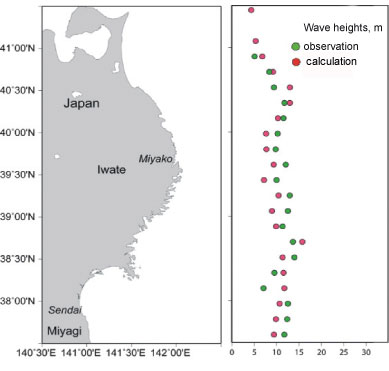 |
|
Distribution of the calculated and observed tsunami wave heights
along the coast of Japan on March 11, 2011
|
Distribution functions of wave heights in the Indian Ocean during the tsunami
on December 26, 2004
|
Anomalously large wind waves abruptly appearing on the sea surface and as rapidly vanishing, which are two or more times larger than background waves (rogue waves), are extremely hazardous for shipping, oil platforms, and off-shore facilities. A catalogue of rogue waves observed in the World Ocean in
2005 — 2010, which shows
their abundance both in the open ocean and in the coastal zone, was compiled at the IAP RAS; the characteristics of rogue waves in the Black Sea, the Sea of Okhotsk, and the Baltic Sea were experimentally studied, and the physical models for the formation of anomalously large waves (dispersion and geometric focusing of wave packets, modulation instability, and the interaction with currents and the wind flow) were developed. The description of rogue waves is based on mathematical models that use the nonlinear evolutionary equations (Korteweg — de Vries equation, nonlinear Schrödinger equation, etc.) and the nonlinearly complete hydrodynamic equations enabling one to take into account the effects of wind wave breaking. The developed models are compared with the data of laboratory research in the basins of Hanover and Marseille in partnership with the IAP RAS experts.
|
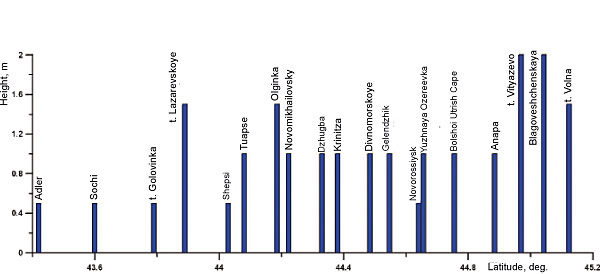 |
Abundance of rogue waves
in various regions of the World Ocean
|
Distribution of the prognostic heights of tsunami waves
along the Russian coast of the Black Sea
|
Various scenarios of the appearance of rogue waves in the ocean are currently calculated to estimate the probabilistic characteristics of anomalously large waves and their life time. The IAP RAS researchers wrote the first world literature monographs on rogue waves; their studies on this topic were awarded prizes for young scientists.
|
The first instrumental record
of a deep-water anomalous wave in the Black Sea
|
 |
Probability of the rogue wave occurrence:
experiment, simulation,theory
|
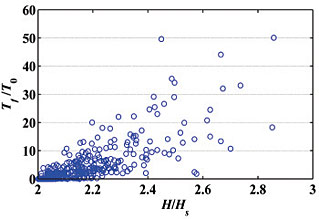 |
Life time of a rogue wave Tf
in the field of wind waves with the period T0 and the height Hs
|
Modeling of wave phenomena.
A unique high-speed wind-wave channel based on the Large thermostratified tank (LTST) gave rise to a new stage of complex studies of wave processes close to the ocean surface. The facility developed under the guidance of Yu. I. Troit
skaya and equipped with instruments for measuring the parameters of wind, waves, and flows enables one to carry out physical modeling of the ocean — atmosphere interaction in a wide range of wind speeds up to the hurricane conditions. This setup is capable of measuring the heat, mass, and energy transfer in the atmospheric boundary layer at a hurricane force wind under the conditions of foam and spray formation, monitoring of the formation of the short-wave part of the surface wave spectrum, and modeling the upper ocean dynamics under the hurricane conditions taking into account the density stratification of sea water
(V. I. Kazakov and D. A. Sergeev).
The modern optical methods based on visualization, including the Particle Image Velocimetry (PIV method), are widely used in the LTST in laboratory experiments on modeling the hydrophysical processes in the boundary layers of the atmosphere and the ocean in experimental hydrophysical facilities. A unique measuring complex has been designed at the Institute for measuring the shape of rough surface and the fields of air and underwater currents
(D. A. Sergeev).
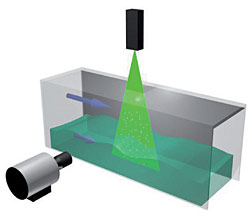 |
|
Schematic of the optical method application to study the wind — wave interaction (left)
and the measured instantaneous velocity field over rough surface in a moving coordinate system
|
It is based on the use of laser knife illumination. To determine the shape of the surface, a fluorescent dye is added to water to provide contrast at the interface. To image flows in the air and liquid, particles
(10—50 μm) are used. The interface and movement of particles in the illumination plane are recorded by digital cameras, including high-speed ones, and are processed with special algorithms on computers. These methods are significantly more efficient than contact measuring methods (Pitot tube, hot-wire anemometers). They allow measuring with high spatial and temporal resolutions in a wide range of flow rates (0—20 m/s) and are successfully used in modeling the wind — wave interaction at strong winds with regular waves breaking and splashes, as well as in study of underwater turbulent flows and their manifestations on the free surface
|
Re = 15000, ka = 0,2, c/u* = 3,3
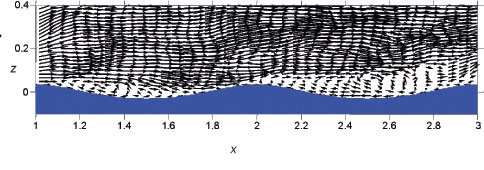
|
Statistical average velocity field
|
Instantaneous vector velocity field
|
| |
|
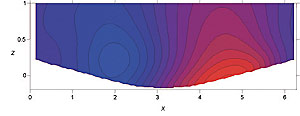 |
 |
| |
Enstrophy field section (the y, z plane)
|
| |
|
 |
 |
Average profiles of velocity and voltage
|
Enstrophy field section (the x, z plane)
|
The elaborated measuring instruments and experimental techniques have provided a significant progress in studying the statistical properties of an air flow over waves in those cases where the boundary layer separation behind wave crests in instantaneous fields is observed. A statistical ensemble of vector velocity fields was obtained using a high-speed shooting with the PIV algorithm. It is found that the averaged velocity field is characterized by a nonseparated flow around wave crests even under harsh storm conditions. A tendency to the drag coefficient saturation at an equivalent wind speed of more than 25 m/s was detected in a laboratory experiment studying the aerodynamic drag of the water surface at strong wind. The effect of stabilizing the aerodynamic drag of the sea surface under hurricane conditions is explained by the screening of the wind flow in surface wave troughs. The results of measuring the aerodynamic drag coefficient of the water surface are in good agreement with the calculations of the turbulent boundary layer over a rough water surface taking into account the contribution of the high-frequency part of the wave spectrum, which are made within the framework of the quasi-linear model.
Besides the development of experimental techniques and theoretical models, of significant importance is direct numerical simulation of the hydrodynamic processes close to the ocean — atmosphere interface. Due to rapid advance in modern computers and the advent of a cluster of parallel calculations at the IAP RAS, the method of direct numerical simulation whithin the framework of primitive three-dimensional Navier — Stokes eqations has been implemented and proved its high effiency for modeling a turbulent air flow over steep surface waves. Being separated from individual wave crests, at the same time, the ensemble-average air flow fields have a nonseparated structure.





